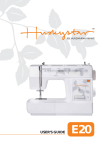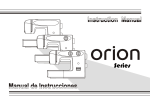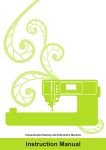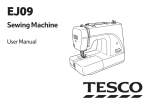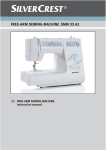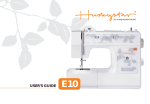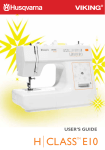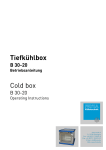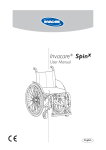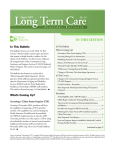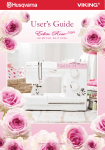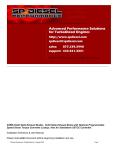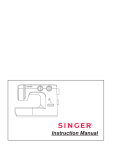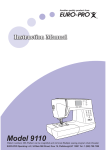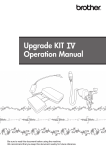Download Smart Parts 100 s User's Manual
Transcript
OWNER´S MANUAL
100 s
This houshold sewing machine is designed to comply with
IEC/EN 60335-2-28 and UL1594
•
IMPORTANT SAFETY
INSTRUCTIONS
Never operate the sewing machine with any air openings blocked. Keep
ventilation openings of the Sewing machine and foot controller free from the
accumulation of lint, dust, and loose cloth.
•
Keep fingers away from all moving parts. Special care is required around the
Sewing machine needle.
•
Always use the proper needle plate. The wrong plate can cause the needle to
break.
•
Do not use bent needles.
•
Do not pull or push fabric while stitching. It may deflect the needle causing it to
break.
•
Switch the sewing machine off (“0”) when making any adjustment in the needle
area, such as threading needle, changing needle, threading bobbin, or changing
presser foot, etc.
•
Always unplug the sewing machine from the electrical outlet when removing
covers, lubricating, or when making any other user servicing adjustments
mentioned in the instruction manual.
•
Never drop or insert any object into any opening.
•
Do not use outdoors.
•
Do not operate where aerosol (spray) products are being used or where oxygen
is being administrated.
•
To disconnect, turn all controls to the off (“0”) position, then remove plug from
outlet.
•
Do not unplug by pulling on cord. To unplug, grasp the plug, not the cord.
When using an electrical appliance, basic safety precautions should always be
followed, including the following:
Read all instructions before using this household sewing machine.
DANGER - To reduce the risk of
electric shock:
•
•
A sewing machine should never be left unattended when plugged in. Always
unplug this sewing machine from the electric outlet immediately after using and
before cleaning.
Always unplug before relamping. Replace bulb with same type rated
10W (110-120V), 15W (220-240V).
WARNING - To reduce the risk of
burns, fire, electric shock, or injury to
persons:
•
Do not allow to be used as a toy. Close attention is necessary when this sewing
machine is used by or near children or infirm person.
•
Use this sewing machine only for its intended use as described in this manual.
Use only attachments recommended by the manufacturer as contained in this
manual.
•
Never operate this sewing machine if it has a damaged cord or plug, if it is not
working properly, if it has been dropped or damaged, or dropped into water.
Return the sewing machine to the nearest authorized dealer or service center for
examination, repair, electrical or mechanical adjustment.
SAVE THESE INSTRUCTIONS
Congratulations
As the owner of a new sewing machine, you are about to begin an exciting adventure in
creativity. From the moment you first use your machine, you will know you are sewing on
one of the easiest to use sewing machines ever made.
May we recommend that, before you start to use your sewing machine, you discover the
many advantages and the ease of operation by going through this instruction, step by step,
seated at your machine.
To ensure that you are always provided with the most modern sewing capabilities, the
manufacturer reserves the right to change the appearance, design or accessories of this
sewing machine.
List of contents
Principal parts of the machine ............................................................................ 2/3
3-step zigzag stitch ............................................................................................. 25
Accessories ........................................................................................................ 4
Straight stretch stitch and Stretch triple zigzag stitch ........................................ 26
Extension table ................................................................................................... 5
Free-motion darning ........................................................................................... 27
Accessory tray .................................................................................................... 6
Darning ............................................................................................................... 28
Connecting machine to power source ................................................................ 7
Free-motion monogramming and embroidering ................................................. 29
Changing the light bulb ....................................................................................... 8
Quilting ............................................................................................................... 30
Presser foot lifter ................................................................................................ 9
Twin needle (Optional) ....................................................................................... 31
Adjusting presser foot pressure .......................................................................... 9
Maintenance ....................................................................................................... 32
Attaching the presser foot holder/presser foot/seam guide ................................ 10
Troubleshooting guide ........................................................................................ 33
Winding the bobbin ............................................................................................. 11
Inserting the bobbin ............................................................................................ 12
Inserting and changing needle ........................................................................... 13
Threading the upper thread ................................................................................ 14
Thread tension ................................................................................................... 15
Raising the bobbin thread .................................................................................. 16
Reverse sewing .................................................................................................. 17
Changing sewing directions ............................................................................... 17
Removing your work ........................................................................................... 17
Cutting the thread ............................................................................................... 17
Matching needle/ fabric/ thread .......................................................................... 18
How to choose your stitch .................................................................................. 19
Straight stitching ................................................................................................ 20
Zigzag stitching .................................................................................................. 21
Overcasting stitches ........................................................................................... 22
Buttonholes ........................................................................................................ 23
Zippers and piping .............................................................................................. 24
Principal parts of the machine
1. Tension dial
2. Bobbin thread guide
3. Thread take-up
4. Reverse lever
5. Thread cutting
6. Presser foot
7. Needle plate
8. Accessory tray
9. Bobbin winder
10. Stitch width dial
11. Stitch length dial
12. Stitch selection dial
13. Extension table
2
Principal parts of the machine
14. Spool pin
15. Bobbin winder stop
16. Hole for second spool pin
17. Handwheel
18. Main switch
19. Main plug socket
20. Presser foot pressure
21. Upper thread guide
22. Handle
23. Presser foot lifter
3
Accessories
a. Standard foot
b. Zipper foot
c. Buttonhole foot
d. Quilting foot
e. Second spool pin
f. Seam ripper/ brush
g. Seam guide
h. Needles
i. Spool caps
j. Bobbins
k. Off-set screwdriver
l. Feed dog cover
m. Free-motion/darning foot
n. Hard cover
o. Felt pad
4
Extension table
Before sewing, please follow the arrow (1) of the drawing, and pull
down the extension table.
Extension table can help your fabric flow easier during sewing.
When the sewing machine is not being used, store the machine with
the extension table folded up.
If you don't need extension table, you can also easily take it off.
First, move the extension table slightly to the left, as the arrow (2),
to unhook the left side and then move it to the right unhooking the
right side (3). You can then take it off.
5
Accessory tray
Keep the snap-in accessory tray horizontal, and push it in the
direction of the arrow. (1)
Remove the accessory tray to sew cylindrical pieces such as sleeve
cuffs.
The inside of the snap-in accessory tray can be utilized to store your
accessories.
To open, lift up at the point of the arrow. (2)
6
Connecting machine to power source
Connect the machine to a power source as illustrated. (1)
The appliance is equipped with a polarized plug which must be used
with the appropriate polarized outlet.
Attention:
Unplug power cord when machine is not in use.
Foot control
Foot control regulates the sewing speed. (2)
Attention:
Consult a qualified electrician if in doubt as to how to connect machine to
power source.
Unplug power cord when machine is not in use.
The appliance must be used with the foot controller:
For USA and Canada, 110-120V: KD-1902
For Australia and Europe, 220-240V: KD-2902
1
Polarized attachment plug
Sewing light
Press main switch (A) for power and light on "l".
For USA and Canada
For appliance with a polarized plug (one blade is wider than the other). To
reduce the risk of electric shock, this plug is intended to fit in a polarized
outlet only one way. If it does not fit fully in the outlet, reverse the plug. If it
still does not fit, contact a qualified electrician to install the proper outlet. Do
not modify the plug in any way.
Conductor
intended to be grounded
7
2
Changing the light bulb
Disconnect the machine from the power supply by removing
the plug from the main socket!
Replace bulb with same type rated 10 watts (110-120V) or 15 watts
(220-240V).
-
-
Loosen screw (A) as illustrated. (1)
Remove the cover (B).
Turn the bulb half a rotation counter clock-wise (C) (2) and
remove the bulb. Push the new bulb upward into the holder as
far as it will go and turn it half a rotation in a clock-wise direction
until it held firmly.
Replace the cover and tighten screw.
Should there be any problem, ask your authorized Pfaff dealer for
advice.
8
Presser foot lifter
The presser foot lifter raises and lowers your presser foot. (A)
When sewing several layers or thick fabrics, the presser foot can be
raised higher for easy positioning of the work. (B)
Adjusting presser foot pressure
Standard presser foot pressure is set at "2".
The presser foot pressure of the machine has been pre-set and
there is no need for change unless sewing particular type of fabric
(light-or-heavy weight).
If you do need to adjust the presser foot pressure, turn the presser
adjusting knob as shown in the picture.
For sewing very thin fabric, loosen the pressure by turning the knob
counterclockwise. The knob will move upward and the pressure will
decrease. If you keep turning the knob, it can be taken out. By that
time, just turn the screw clockwise, until it lockes back in place and
readjust the pressure.
For heavy fabric, tighten the pressure by turning the knob clockwise
and the knob will move downward and the pressure is increased.
When the knob can not be moved any further, it has reached the
bottom. Please do not turn it any more.
9
Attaching the presser foot holder/presser foot/seam guide
Raise the presser bar (a). (1)
Attach the presser foot holder (b) as illustrated.
Attaching the presser foot
Lower the presser foot holder (b) until the cut-out (c) is directly
above the pin (d). (2)
Raise the lever (e).
Lower the presser foot holder (b) and the presser foot (f) will engage
automatically.
Removing the presser foot
Raise the presser foot. (3)
Raise the lever (e) and the foot disengages.
Note: You can use the standard foot for all stitches.
Attaching the seam guide
Attach the seam guide (g) in the slot as illustrated.
Adjust according to need for hems, pleats, etc. (4)
Attention:
Turn power switch to off ("O") when carrying out any of the above
operations!
10
Winding the bobbin
-
-
Place thread and spool cap onto spool pin (1).
For smaller spools of thread place spool cap with small
side next to spool (2).
Snap thread into thread guide (3).
Wind thread clockwise around bobbin winder tension discs
(4).
Thread bobbin as illustrated and place on spindle (5).
Push bobbin to right (6).
Hold thread end (7). Step on foot control (8).
Cut thread (9). Press bobbin to left (10) and remove.
Please Note:
When the bobbin winder spindle is in "bobbin winding" position,
the machine will not sew and the handwheel will not turn. To start
sewing, push the bobbin winder spindle to the left (sewing position).
11
Inserting the bobbin
When inserting or removing the bobbin, the needle must be in
the highest position.
1. Insert the bobbin in the bobbin case with the thread
running counterclockwise direction (arrow).
2. Pull the thread through the slit (A).
3. Draw the thread clockwise until it slips into the notch (B).
4. Pull out about 15 cm (6 inches) of thread and attach the
bobbin cover plate. (C)
Attention:
Turn power switch to off ("O") before inserting or removing the bobbin.
12
Inserting and changing needle
Change the needle regularly, especially if it is showing signs of wear
and causing problems.
Insert the needle following the illustrated instructions.
A. Loosen the needle clamp screw and tighten again after inserting
the new needle. (1)
B. The flat side of the needle should be towards the back.
C-D. Insert the needle as far up as it will go.
Attention:
Turn power switch to off ("O").
Needles must be in perfect condition. (2)
Problems can occur with:
A. Bent needles
B. Damaged points
C. Blunt needles
13
Threading the upper thread
This is a simple operation but it is important to carry out correctly.
-
Start by raising the needle to its highest point (1), and also raise
the presser foot to open the tension discs. (2)
Note:
For safety, it is strongly suggested you turn off the power before threading.
-
-
-
Lift up the spool pin. Place the spool of thread on the holder
with the thread coming off the spool as shown. For small thread
spools, place small side of spool cap next to spool.(3)
Draw thread from spool through the upper thread guide. (4)
Guide thread around thread guide (5) pulling thread through pretension spring as illustrated.
Thread tension module by leading thread down right channel and
up left channel (6). During this process it is helpful to hold the
thread between the spool and thread guide (4).
At the top of this movement pass thread from right to left through
the slotted eye of the take-up lever and then downwards again. (7)
Pass thread behind the flat, horizontal thread guide. (8)
Now take thread behind the thin wire needle clamp guide and then
down to the needle which should be threaded from front to back.
Pull about 6-8 inches of thread to the rear beyond the needle eye.
(9)
14
Thread tension
Upper thread tension
Basic thread tension setting: "4"
To increase the tension, turn the dial to the next number up.
To reduce the tension, turn the dial to the next number down.
A. Normal thread tension for straight stitch sewing.
B. Thread tension too loose for straight stitch sewing.
Turn dial to higher number.
C. Thread tension too tight for straight stitch sewing.
Turn dial to lower number.
D. Normal thread tension for zigzag and decorative sewing.
Please note:
- Proper setting of tension is important to good sewing.
- There is no single tension setting appropriate for all stitch
functions, thread on fabric.
- A balanced tension (identical stitches both top and bottom) is
usually only desirable for straight stitch construction sewing.
- 90% of all sewing will be between "3" and "5" ("4" is basic
setting).
- For zigzag and decorative sewing stitch functions, thread tension
should generally be less than for straight stitch sewing.
- For all decorative sewing you will always obtain a nicer stitch
and less fabric puckering when the upper thread appears on the
bottom side of your fabric.
15
Raising the bobbin thread
Hold the upper thread with the left hand. Turn the handwheel (1)
towards you (counterclockwise) lowering, then raising needle.
Gently pull on the upper thread to bring the bobbin thread up
through the needle plate hole (2).
Lay both threads to the back under the presser foot. (3)
16
Reverse sewing
Reverse sewing is used for locking the end of seams and where
reinforcement is needed. At the end of seam, press down the
reverse sewing lever and touch the foot control lightly. Sew a few
reverse stitches. Release lever and the machine will sew forwards
again (A/1).
Changing sewing directions
1. Stop the machine at the point where you wish to change
directions with the needle still in the fabric.
2. Raise the presser foot and turn the fabric to line up its new
direction using the needle as a turning point. (2)
3. Lower the presser foot and start sewing in the new direction.
Removing your work
Turn the handwheel towards you to bring the thread take up lever to
its highest position. Raise the presser foot and draw the fabric away
from you. (3)
Cutting the thread
Hold the threads behind the presser foot with both hands, guide
them to the slit (B) and press down. (4)
17
Matching needle/ fabric/ thread
NEEDLE, FABRIC, THREAD SELECTION GUIDE
NEEDLE SIZE
FABRICS
THREAD
9-11 (70-80)
Lightweight fabrics: thin cottons, voile, serge, silk , muslin, Qiana,
interlocks, cotton knits, tricot, jerseys, crepes, woven polyester, shirt &
blouse fabrics.
Light-duty thread in cotton, nylon, polyester or cotton
wrapped polyester.
11-14 (80-90)
Medium weight fabrics: cotton, satin, kettleclote, sailcloth, double knits,
lightweight woollens.
14 (90)
Medium weight fabrics: cotton duck, woolen, heavier knits, terrycloth,
denims.
16 (100)
Heavyweight fabrics: canvas, woolens, outdoor tent and quilted fabrics,
denims, upholstery material (light to medium).
Most threads sold are medium size and suitable for
these fabrics and needle sizes.
Use polyester threads on synthetic materials and cotton
on natural woven fabrics for best results. Always use the
same thread on top and bottom.
18 (110)
Heavy woolens, overcoat fabrics, upholstery fabrics, some leathers and
vinyls.
Heavy duty thread, carpet thread.
(Use heavy foot pressure-heavy numbers.)
IMPORTANT: Match needle size to thread size and weight of fabric.
NEEDLE, FABRIC SELECTION
NEEDLES
EXPLANATION
TYPE OF FABRIC
HA x 1
15 x 1
Standard sharp needles. Sizes range thin to
large. 9 (65) to 18 (110)
Natural woven fabrics-wool, cotton, silk, etc. Qiana. Not recommended for double
knits.
15 x 1/705H
Semi-ball point needle, scarfed.
9 (65) to 18 (110)
Natural and synthetic woven fabrics, polyester blends. Knits-polyesters,
interlocks, tricot, single and double knits. Can be used instead of 15 x 1 for
sewing all fabrics.
15 x 1/705H (SUK)
Twin Needle.
Woven fabrics and knits.
130 PCL
Leather needles. 12 (80) to 18 (110)
Leather, vinyl, upholstery. (Leaves smaller hole than standard large needle.)
Note:
1. Twin needles, can be purchased for utility and decorative work.
2. When sewing with twin needles, the stitch width dial should be set at less than "3".
3. For best sewing results always use genuine needles.
4. Replace needle often (approximately every other garment ) and/ or at first thread breakage or skipped stitches.
18
How to choose your stitch
Reverse lever
To select a stitch, simply turn the stitch selection dial. The stitch
selection dial may be turned in either direction. The following page
shows the recommended range of stitch lengths and widths.
Stitch width dial
Stitch length dial
Adjust the stitch length with the stitch length dial. You may choose
stitch width by turning the stitch width dial.
Adjust the stitch length and stitch width according to the fabric being
used.
Stitch selection dial
To obtain any of the other stitches shown in the upper row on the
stitch selection panel, select the letter above the stitch with the stitch
selection dial. Adjust the stitch length and the stitch width with the
control dials according to the result desired.
To obtain any of the stitches on the second row, turn the stitch length
dial to "S1" or "S2", select the stitch desired with stitch selection dial,
and adjust the stitch width with the stitch width dial.
19
Straight stitching
Turn the stitch selection dial so that the stitch display shows the
straight stitch position.
Stitch width dial
Generally speaking, the thicker the fabric, thread and needle, the
longer the stitch should be.
Stitch length dial
20
Zigzag stitching
Stitch width dial
Turn the stitch selector dial to "A".
Function of stitch width dial
The maximum zigzag stitch width for zigzag stitching is "6"; however,
the width can be reduced on any pattern. The width increases as
you move zigzag dial from "0" - "6".
For twin needle sewing, never set the width wider than "3". (1)
Function of stitch length dial while zigzagging
The density of zigzag stitches increase as the setting of stitch length
dial approaches "0".
Neat zigzag stitches are usually achieved at "2.5" or below.
Closed up zigzag stitches (close together) are referred to as a satin
stitch. (2)
Stitch length dial
21
Overcasting stitches
Seams, overcasting, visible hems.
Turn stitch width dial to "6".
Stretch overlock: (1)
Turn stitch length dial to "S1".
The stitch width can be adjusted to suit the fabric.
For fine knits, jerseys, neck edges, ribbing.
Standard overlock: (2)
Turn stitch length dial to "S2".
The stitch width can be adjusted to suit the fabric.
For fine knits, jerseys, neck edges, ribbing.
All overlock stitches are suitable for sewing and neatening edges
and visible seams in one operation.
When neatening, the needle should just go over the edge of the
fabric.
Attention:
Use new needles or ball point needles or stretch needle!
22
Buttonholes
Prepare
1. Take off the standard foot and attach the buttonhole foot.
2. Measure diameter and thickness of button and add 0.3 cm (1/8”)
for bar tacks; mark buttonhole size on fabric.
3. Place fabric under the foot, so that marking of the buttonhole foot
aligns with marking of fabric. Lower the foot, so that the center
line of the fabric buttonhole come to the center of the foot hole.
Adjust the stitch length dial in the "
" to set stitch density.
Set stitch width control between "4" - "6".
Note: density varies according to the fabric. Always sew a test buttonhole.
Follow the 4-step sequence changing from one step to another
with the stitch pattern selector dial. Take care not to sew too many
stitches in stages 1 and 3. Cut buttonhole open from both ends
towards the middle.
Tips:
- Slightly reduce upper thread tension produce better results.
- Use a backing for fine or stretchy fabrics.
- It is advisable to use heavy thread or cord for stretch or knit
fabrics.
- The zigzag should sew over the heavy thread or cord.
23
Zippers and piping
Set the pattern selector dial to " ".
Turn stitch width dial to "0".
Set stitch length control between "1" - "4".
Change to zipper foot (1).
The zipper foot can be attached right (2) or left (3) depending on
which side of the foot you are going to sew.
To sew past the zipper pull, lower the needle into the fabric, raise the
presser foot and push the zipper pull behind the presser foot. Lower
the foot and continue to sew.
It is also possible to sew in a length of cord, into a bias strip to form
a welt (4).
24
3-step zigzag stitch
Sewing on lace and elastic, darning, mending, reinforcing edges.
Set the machine as illustrated.
Set stitch width control between "4" - "6".
Set stitch length control between "1" - "2".
Place the patch in position. The stitch length can be shortened to
produce very close stitches. (1)
When mending tears, it is advisable to use a piece of backing fabric
to reinforce. The stitch density can be varied by adjusting the stitch
length. First sew over the center and then overlap on both sides.
Depending on the type of fabric and damage, sew between 3 and 5
rows. (2)
Sewing elastic
- Place the elastic on the fabric.
- As you sew, stretch the elastic both in the front and behind the
presser foot as shown in fig. (3).
Joining fabric
The elastic stitch can be used to join two pieces of fabric together
and is very effective when sewing knitted fabrics. If nylon thread is
used, the stitch will not be visible.
- Place the edges of the two pieces of fabric together and center
them under the presser foot.
- Sew them together using the elastic stitch taking care to keep
the two fabric edges close together as shown in fig. (4).
25
Straight stretch stitch and Stretch triple zigzag stitch
Straight stretch stitch
Set the stitch pattern dial to "A".
Used to add triple reinforcement to stretch and hardwearing seams.
Set the stitch length dial to "S1".
Set the stitch width dial to "0".
Stretch triple zigzag stitch
Set the stitch pattern dial to "A".
Used primarily as a decorative stitch.
Set the stitch length dial to "S1".
Adjust the stitch width dial to between "4" and "6".
Stretch triple zigzag stitch is suitable for firm fabrics like denim,
poplin, duck, etc.
Straight stretch stitch
26
Stretch triple zigzag stitch
Free-motion darning
Install the feed dog cover. (1)
Set the stitch length dial to "0".
Set the stitch width dial to "0".
Remove the presser foot clamp. (2)
Attach the free-motion/darning foot to the presser foot holder. The
lever (A) should be behind the needle clamp screw (B). Press the
free-motion foot on firmly from behind with your index finger and
tighten the screw (C). (3)
For darning, first sew around the edge of the hole (to secure the
threads). (4)
First row: Always work from left to right. Turn work by 1/4 and
oversew.
A darning hoop is recommended for easier sewing and better
results.
Note:
Free-motion darning is accomplished without the sewing machine internal
feed system. Movement of the fabric is controlled by the operator. It is
necessary to coordinate sewing speed and movement of fabric.
27
Darning
-
Set the machine as illustrated.
-
Turn stitch width dial to "0".
-
Turn stitch length dial to the desired length.
-
Position the fabric to be darned under the presser foot together
with the under laying fabric to be used.
-
Lower the presser foot and alternately sew forward or reverse
using the lever.
-
Repeat this motion until the area to be darned is filled with rows
of stitching.
For reverse sewing instructions, see page 17.
28
Free-motion monogramming and embroidering
-
Set the machine as illustrated.
Turn stitch width dial to "0".
Remove the presser foot and the presser foot holder.
Attach the feed dog cover. (1)
Lower presser foot lever before starting to sew.
Adjust the stitch width according to the size of lettering or design.
Preparation for Monogramming and Embroidering*
- Draw the desired lettering or design on the right side of the fabric.
- Stretch the fabric between embroidery hoop as firmly as possible.
- Place the fabric under the needle. Make sure the presser foot
bar is down in its lowest position.
- Turn the balance wheel towards you to bring up the lower thread
through the fabric. Sew a few securing stitches at the starting
point.
- Hold the hoop with thumb and forefingers of both hands while
pressing the material with the middle and third fingers and
supporting the outside of hoop with smaller finger.
* Embroidery hoop not included with machine.
29
Quilting
Set stitch selector as illustrated.
Turn stitch width dial to "0".
Turn stitch length dial to the desired length.
Insert the quilting guide in presser foot holder and set the space as
you desired. Use the quilting foot.
Move the fabric over and sew successive rows with the guide riding
along on the previous row of stitching.
30
Twin needle (Optional)
-
Turn stitch width dial to "0".
-
Turn stitch length dial to the desired stitch length.
-
Turn stitch selector to straight stitch, center needle position.
-
For twin needle sewing, insert the extra spool pin (included with
the accessories) into the hole on top of the machine.
-
Make sure that the two threads used to thread the twin needle
are of the same weight. You can use one or two colors.
-
Insert the twin needle in the same way as single needle. Flat side
of needle should face away from you.
-
Follow instructions for single needle threading.
Thread each needle separately.
Please Note:
When sewing with twin needle, always proceed slowly, and make sure to
maintain a low speed to insure quality stitching.
When using twin needle on zigzag make sure the stitch width dial is set
between "1" and "3". Do not use twin needle at setting above "3".
31
Maintenance
Attention:
Disconnect the machine from the wall outlet before carrying out any
maintenance or changing the sewing light bulb.
Cleaning
If lint and bits of thread accumulate in the hook, this will interfere
with the smooth operation of the machine. Check regularly and
clean the stitching mechanism when necessary.
A.Bobbin holder
1. Remove the bobbin cover plate and bobbin.
2. Clean the bobbin holder with a brush.
B.Hook race and feed dog
1. Remove the needle, presser foot and holder.
Remove the bobbin cover plate and bobbin.
Remove the screw holding the needle plate and remove the
needle plate.
2. Lift up bobbin case and remove it.
3. Clean the hook race, feed dog and bobbin case with a brush.
Also clean them, using a soft, dry cloth.
4. Replace the bobbin case into the hook race so that the tip (a) fits
to the stopper (b) as shown.
32
Troubleshooting guide
Problem
Cause
Correction
Upper thread breaks
1.The machine is not threaded correctly.
2.The thread tension is too tight.
3.The thread is too thick for the needle.
4.The needle is not inserted correctly.
5.The thread is wound around the spool holder pin.
6.The needle is damaged.
1.Rethread the machine.
2.Reduce the thread tension. (lower number)
3.Select a larger needle.
4.Remove and reinsert the needle. (flat side towards the back)
5.Remove the spool and thread from the spool holder pin.
6.Replace the needle.
Lower thread breaks
1.The bobbin case is not inserted correctly.
2.The bobbin case is threaded wrong.
3.The lower thread tension is too tight.
1.Remove and reinsert the bobbin case and pull on the thread. The thread
should pull easily.
2.Check both bobbin and bobbin case.
3.Loosen lower thread tension as described.
Skipped stitches
1.The needle is not inserted correctly.
2.The needle is damaged.
3.The wrong size needle has been used.
4.The foot is not attached correctly.
1.Remove and reinsert needle. (flat side towards the back)
2.Insert a new needle.
3.Choose a needle to suit the thread and fabric.
4.Check and attach correctly.
Needle breaks
1.The needle is damaged.
2.The needle is not correctly inserted.
3.Wrong needle size for the fabric.
4.The wrong foot is attached.
1.Insert a new needle.
2.Insert the needle correctly. (flat side towards the back)
3.Choose a needle to suit the thread and fabric.
4.Select the correct foot.
Loose stitches
1.The machine is not correctly threaded.
2.The bobbin case is not correctly threaded.
3.Needle/ fabric/ thread combination is wrong.
4.Thread tension wrong.
1.Check the threading.
2.Thread the bobbin case as illustrated.
3.The needle size must suit the fabric and thread.
4.Correct the thread tension.
Seams gather or
pucker
1.The needle is too thick for the fabric.
2.The stitch length is wrong adjusted.
3.The thread tension is too tight.
1.Select a finer needle.
2.Readjust the stitch length.
3.Loosen the thread tension.
Uneven stitches,
uneven feed
1.Poor quality thread.
2.The bobbin case is wrong threaded.
3.Fabric has been pulled.
1.Select a better quality thread.
2.Remove bobbin case, thread and insert correctly.
3.Do not pull on the fabric while sewing, let it be taken up by the machine.
The machine is noisy
1.Fluff or oil have collected on the hook or needle bar.
2.The needle is damaged.
1.Clean the hook and feed dog as described.
2.Replace the needle
The machine jams
Thread is caught in the hook.
Remove the upper thread and bobbin case, turn the handwheel
backwards and forwards by hand and remove the thread remands.
33
Please note that on disposal, this product must be safely
recycled in accordance with relevant National legislation
relating to electrical/electronic products. If in doubt please
contact your retailer for guidance
www.pfaff.com
412 97 76-26B • English • Inhouse production • © 2005 VSM Group AB • All statements valid at time of printing • Printed in China on environmental-friendly paper •
VSM Group AB • SE-561 84 Huskvarna • SWEDEN








































